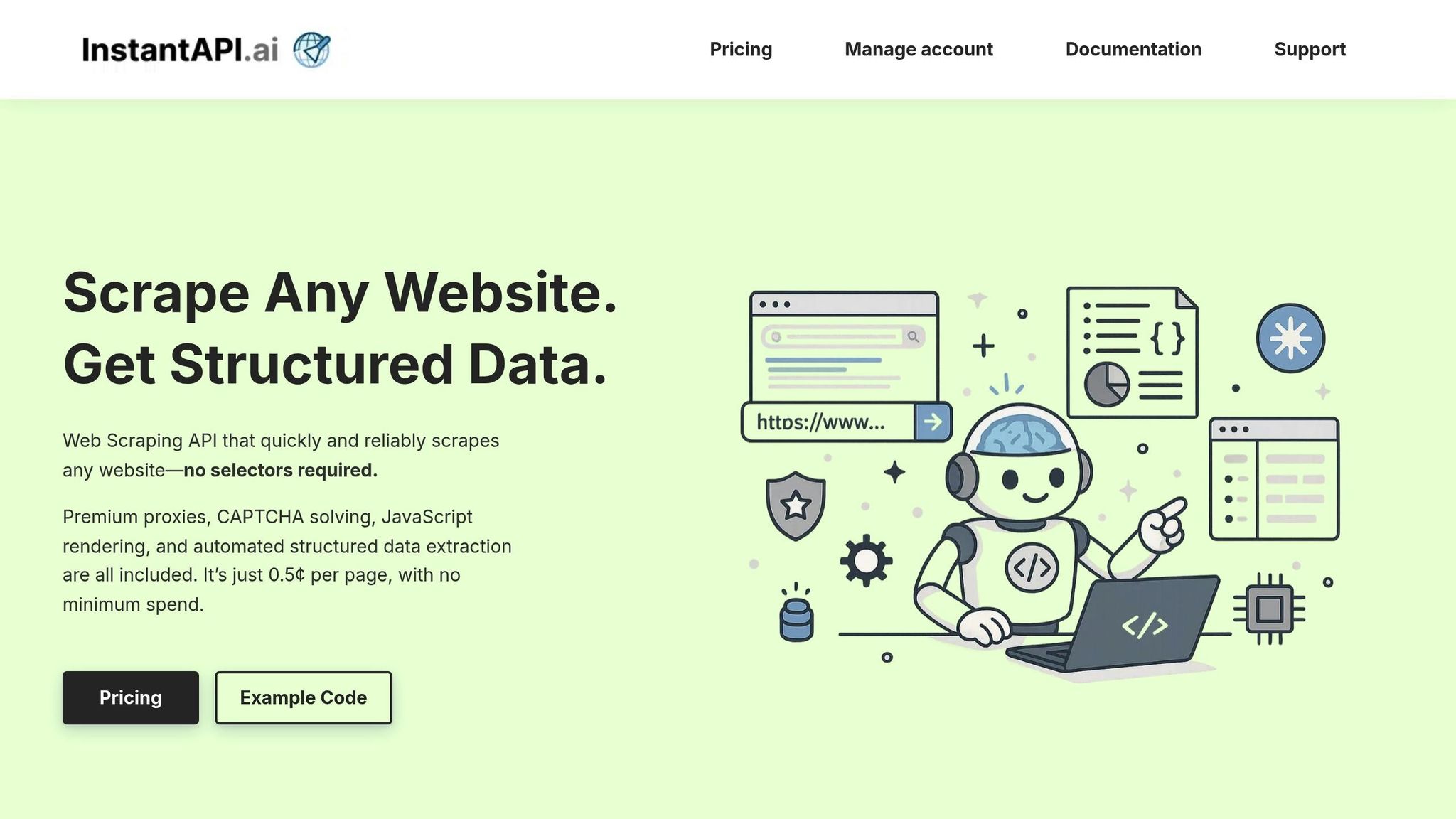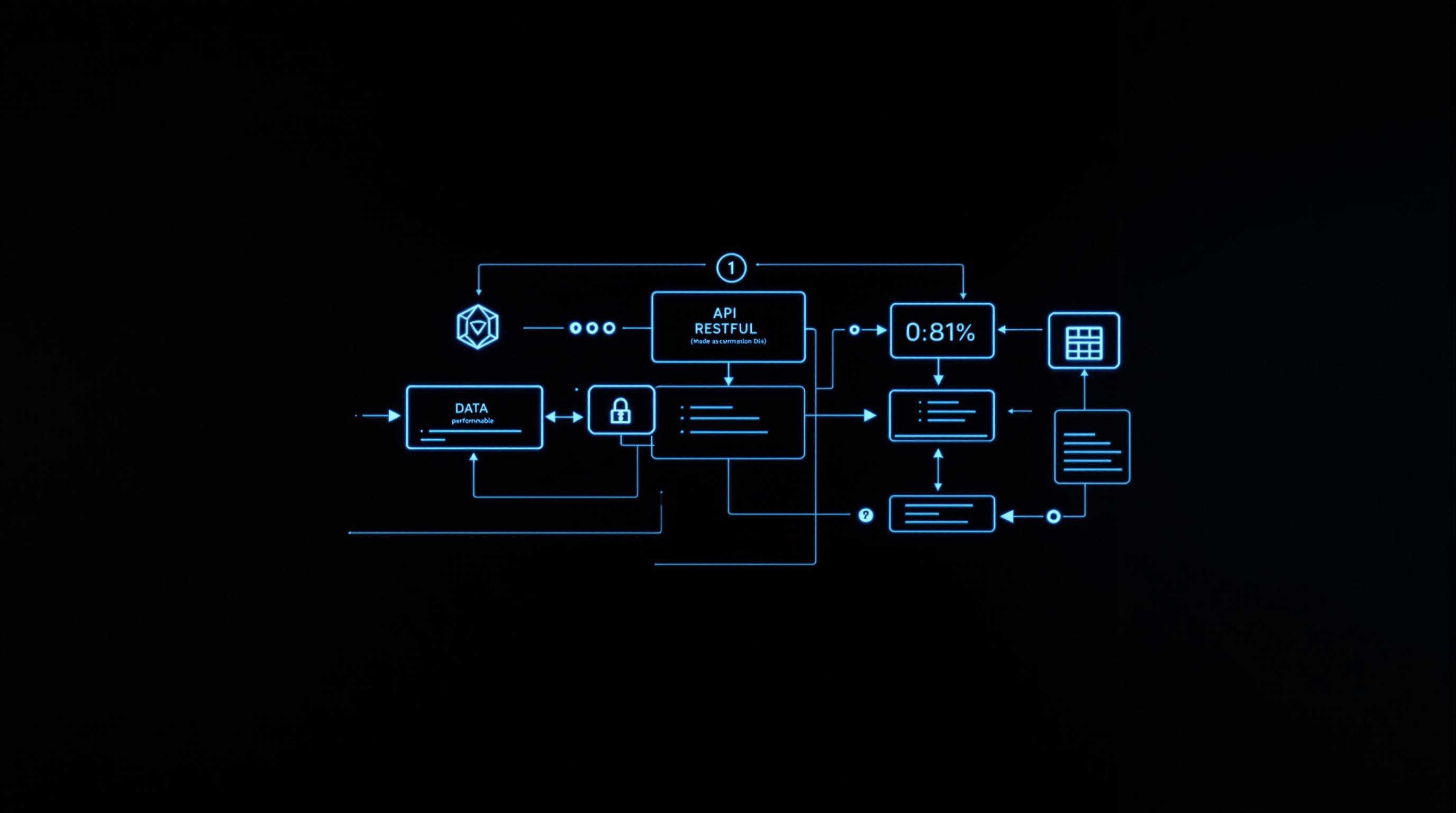Web scraping helps businesses quickly gather and analyze social media data from platforms like Twitter, Instagram, and LinkedIn. By automating data collection, companies can track hashtags, analyze user sentiment, and monitor brand mentions in real-time. This allows for better market insights, customer feedback, and competitor analysis.
Key Points:
- Benefits: Real-time trend tracking, customer insights, and competitive analysis.
- Tools Needed: Python libraries like
Requests,BeautifulSoup4,Selenium, andScrapy. - Challenges: Rate limits, dynamic content, and privacy regulations like GDPR/CCPA.
- Ethics: Always follow platform rules, respect user privacy, and use APIs when available.
Quick Comparison of Scraping Methods:
| Method | Use Case | Tools | Challenges |
|---|---|---|---|
| Static Content | Basic HTML data | BeautifulSoup | Limited to non-JavaScript data |
| Dynamic Content | JavaScript-heavy pages | Selenium | Complex setup |
| API Data Collection | Structured platform data | APIs | Rate limits and authentication |
By using ethical practices and the right tools, web scraping can turn raw social media data into actionable insights for businesses.
[Tutorial] How to scrape and analyze social media data
Getting Started with Web Scraping
Here's how to set up a scraping environment to gather social media insights effectively.
Pick Your Programming Language
Python is a great choice for web scraping, especially for social media platforms. Its simple syntax and wide range of libraries make it a go-to option for both beginners and experienced developers.
| Language Feature | Why Python Stands Out |
|---|---|
| Learning Curve | Easy-to-understand syntax |
| Library Support | Plenty of scraping tools |
| Community | Strong and active developer base |
| Documentation | Detailed guides and examples |
| Performance | Suitable for most scraping tasks |
Once you've decided on Python, the next step is to get the right tools.
Required Libraries
Python's ecosystem offers several libraries that simplify scraping tasks. Here are the essentials:
- Requests: For making HTTP requests
- BeautifulSoup4: For parsing HTML content
- Selenium: For handling dynamic web pages
- Scrapy: For managing large-scale data extraction
You can install these libraries using pip. Just run:
pip install requests beautifulsoup4 selenium scrapy
Development Setup
Follow these steps to configure your development environment:
- Install Python and set up your preferred IDE (e.g., Visual Studio Code).
- Define your headers to mimic a browser request:
headers = {
"User-Agent": "Mozilla/5.0 (Macintosh; Intel Mac OS X 10_15_7) AppleWebKit/537.36"
}
To avoid getting blocked, make sure to include techniques like rate limiting, rotating proxies, and exponential backoff in your scraping strategy.
For a smoother workflow, consider using Jupyter Notebooks. They allow you to:
- Test and tweak code in real-time
- Instantly visualize the data you extract
- Debug more efficiently
- Keep a well-documented record of your process
Lastly, secure any API keys or authentication tokens by storing them as environment variables. This keeps your sensitive information safe.
Choose Your Social Platforms
Select social media platforms based on your project goals and the type of data you need. This step builds on your earlier setup by matching platform features with the tools you’re using.
Main Social Media Sources
Different platforms provide unique data and present specific challenges. Here’s a quick breakdown of key platforms, the type of data they offer, and their best uses:
| Platform | Key Data Types | Best Use Cases | Active Users |
|---|---|---|---|
| Twitter (X.com) | Hashtags, mentions, real-time trends | Breaking news, public sentiment | 321M+ |
| Visual content, hashtags, engagement metrics | Brand monitoring, influencer tracking | 1B+ | |
| Professional profiles, company updates | B2B insights, industry trends | 830M+ | |
| User engagement, brand mentions | Customer segmentation, market research | 2.5B+ |
Studies reveal that over 70% of executives rely on social media data daily.
Nanqin Ying, a Data Science Fellow at the Goldman School of Public Policy, highlights:
"Web scraping remains a valuable tool for extracting insights from social media, but increasing regulations and evolving platform policies have reshaped its landscape."
Next, let’s look at the technical and regulatory challenges involved in scraping these platforms.
Common Scraping Obstacles
Scraping social media data comes with several hurdles, both technical and regulatory:
1. Rate Limiting and API Restrictions
Platforms enforce strict limits on API usage. For example, Twitter’s tiered pricing for API access has reduced free-tier availability. To navigate this:
- Add delays between requests to avoid being flagged
- Use rotating proxies to distribute requests
- Opt for paid API access for reliable data retrieval
2. Platform Security Measures
Social platforms use advanced anti-scraping techniques, such as:
- Dynamic content rendering
- JavaScript obfuscation
- IP-based restrictions
- CAPTCHA challenges
3. Data Privacy Compliance
Data collection must align with privacy laws like GDPR and CCPA. This includes:
- Removing personally identifiable information (PII)
- Documenting data collection methods
- Respecting platform terms of service
For instance, Bright Data Blog (2022) reported that LinkedIn’s algorithm updates caused fluctuations in scraping bandwidth, requiring constant tool adjustments.
Overcoming these challenges is crucial for gathering accurate data and keeping up with trends.
sbb-itb-f2fbbd7
Web Scraping Methods
Here are three practical ways to extract social media data. These methods address common platform challenges and provide workable solutions.
Static Content Scraping
This method focuses on pulling data directly from static HTML. It's best suited for social media elements that don’t rely on JavaScript, like user profiles or basic page details.
Beautiful Soup is a great tool for parsing static HTML. Below is a quick comparison of common techniques for extracting static content:
| Feature | Performance | Best Use Case | Resource Usage |
|---|---|---|---|
| HTML Parsing | Fast | Basic profiles, text content | Low |
| CSS Selectors | Medium | Structured layouts | Medium |
| XPath | High | Complex nested elements | Medium |
For websites requiring JavaScript to render content, static scraping won’t cut it. That’s where dynamic scraping steps in.
Dynamic Content Scraping
Social media platforms often use JavaScript to load content dynamically. Tools like Selenium are ideal for handling this type of data. They can manage infinite scrolling, real-time updates, and other interactive elements.
For instance, in March 2024, a social media analytics company successfully used Selenium to scrape TikTok comments. They incorporated techniques like explicit waits, scrolling delays, and session cookie management to keep the process smooth and maintain authentication.
If scraping dynamic content becomes too complex, APIs can simplify the task.
API Data Collection
APIs provide structured and direct access to platform data. While they come with rate limits and specific terms of service, they are a reliable alternative to scraping.
Key considerations for using APIs include:
- Authentication Management: Use secure methods like OAuth or API keys. Keep credentials safe and rotate tokens regularly.
- Rate Limit Handling: Monitor API usage and apply smart throttling to avoid hitting limits while maximizing data collection.
- Data Processing: APIs typically return data in JSON or XML formats, so you’ll need strong pipelines for parsing and cleaning.
You can combine these methods to tackle different scenarios effectively.
Data Analysis and Display
Turn your raw social media data into clear, actionable insights by processing it effectively and presenting it with easy-to-understand visuals.
Data Cleanup
Start by tidying up your data. Strip out HTML tags, eliminate extra spaces, and convert text-based numbers into numerical formats for easier analysis.
Data Standardization:
| Data Type | Cleaning Method | Example |
|---|---|---|
| Dates | Convert to MM/DD/YYYY | "March 15" → "03/15/2025" |
| Numbers | Remove commas and standardize decimals | "1,234.56" → 1234.56 |
| Boolean Values | Convert text to TRUE/FALSE | "yes/no" → TRUE/FALSE |
| Empty Fields | Replace with NULL or an appropriate value | "" → NULL |
Accurate and clean data is the foundation for spotting trends effectively.
Trend Detection
Focus on analyzing key performance metrics to uncover trends:
- Engagement Analysis: Track post frequency, interaction rates (likes, shares, comments), peak activity times, and hashtag performance.
- Sentiment Tracking: Use sentiment analysis tools to gauge the emotional tone of your audience. This can reveal how your content resonates and what reactions it triggers.
Identifying these trends allows you to turn raw data into meaningful insights.
Data Visualization
Bring your findings to life with visual tools that make trends easy to understand:
- Time-Based Trends: Use libraries like Seaborn to create charts that show daily engagement patterns, weekly cycles, and monthly growth.
- Engagement Metrics: Develop comparative visuals to highlight interaction rates by post type, time of day, or content category.
Clear, well-designed graphs with proper color coding will make significant patterns stand out, helping you turn insights into actionable strategies.
Ethics and Guidelines
When collecting data from social media, it’s crucial to stick to ethical practices and follow legal rules. These ensure your methods are responsible and efficient.
Platform Rules
Social media platforms have specific terms for data collection. Stay compliant by following these strategies:
| Platform Requirement | How to Comply |
|---|---|
| Rate Limiting | Stick to the platform’s rate limits |
| Data Access | Check the robots.txt file to see what’s allowed |
| Authentication | Use a valid User-Agent string with contact info |
| API Priority | Always use platform APIs when they’re available |
"The API way is often the best way... This means that you'd be doing it according to their rules; you have been authorized to get the information. So, if there's an API, use it instead of scraping."
While these rules shape your technical approach, respecting user privacy is equally important.
Data Privacy
To protect user rights, follow these key practices:
-
Data Collection Boundaries
Collect only public information needed for trend analysis. Keep detailed records of your methods and how long you’ll retain the data. -
Data Security
Secure your data by encrypting it, masking identifiers, and using strict access controls. Regularly audit your security measures. -
Compliance Requirements
Abide by GDPR and CCPA regulations. Keep thorough records of data processing and establish clear retention policies.
"As you can see, it is a matter of respect, good manners, and proper human relationships to keep your web scraping healthy and ethical."
Summary
Main Points
Web scraping can be a game-changer for tracking social media trends. Here are the essential components that make it successful:
| Component | Purpose | Benefit |
|---|---|---|
| Programming Foundation | Builds tailored scraping solutions | Allows flexible data gathering |
| Data Collection | Gathers relevant content | Ensures accurate extractions |
| Processing Methods | Manages various content types | Handles both static and dynamic data |
| Ethics & Compliance | Promotes responsible practices | Supports sustainable operations |
These elements help businesses tap into social media insights effectively.
InstantAPI.ai Overview

InstantAPI.ai makes social media trend tracking easier with its efficient web scraping features. By following ethical standards and using advanced techniques, it offers:
- Global Reach: Access to data from over 195 countries for comprehensive trend analysis
- Consistent Performance: Handles JavaScript-heavy pages and CAPTCHAs without breaking a sweat
- Budget-Friendly Pricing: Just $0.005 per page scrape, with no minimum spend required
"After trying other options, we were won over by the simplicity of InstantAPI.ai's Web Scraping API. It's fast, easy, and allows us to focus on what matters most - our core features." - Juan, Scalista GmbH
With the ability to process unlimited simultaneous requests, it's perfect for real-time trend tracking. Plus, its smart data transformation tools make it easy to customize formats, turning raw data into actionable insights.


